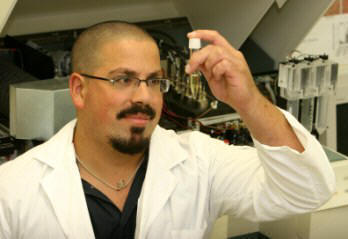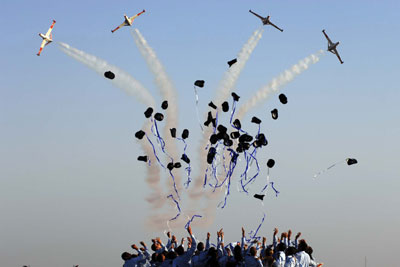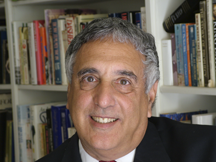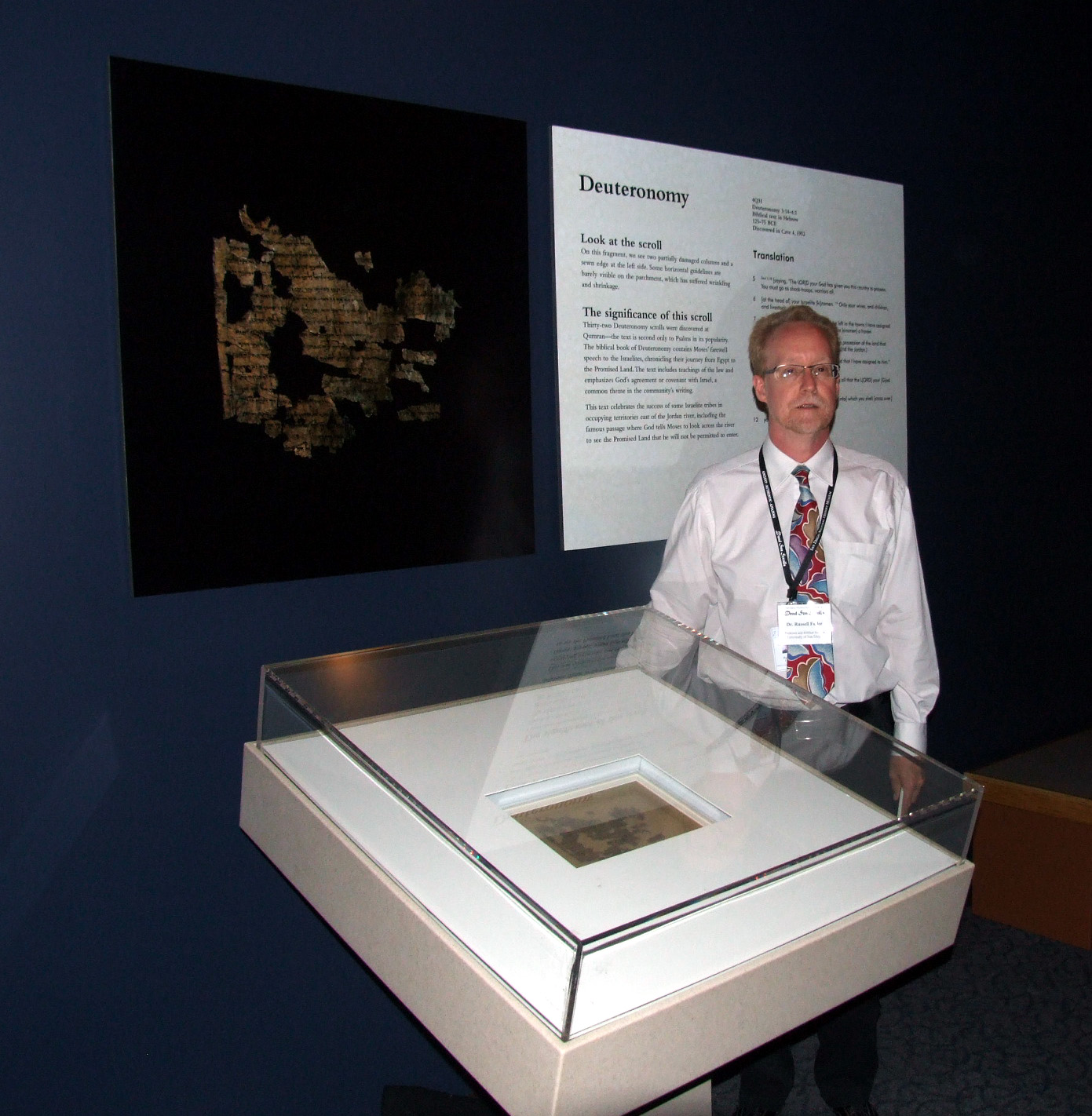Hebrew University sees
hope for asthma cure

Doctoral candidate
Ido Bachelet in his laboratory
JERUSALEM (Press Release)—Allergies, like
the common cold and asthma, have basically
defied the best efforts of modern medicine to
cure them. Now, a doctoral candidate at the
Hebrew University of Jerusalem School of
Pharmacy has come up with a new approach that
offers hope for getting rid of them.
For his efforts, Chilean-born Ido Bachelet, a
first cousin of the president of Chile, Michelle
Bachelet, and a Ph.D. student under the
supervision of Prof. Francesca Levi-Schaffer,
has been named the winner of one of this year’s
Barenholz Prizes for Creativity and Originality
in Applied Research. The award, named for its
donor, Yehezkel Barenholz, the Dr. Daniel G.
Miller Professor of Cancer Research at the
Hebrew University-Hadassah Medical School, was
presented recently during the Hebrew University
Board of Governors 70th meeting.
San
Diego Jewish World
Saturday
Evening,
June 30, 2007
Vol. 1, Number
61
|
Archives Community Calendar HOME Jewish Directory Jewish Grapevine Jews in the News News Sleuths |
|
6/30/07
SDJW Report |
|
|
Bachelet’s research has focused on mechanisms that regulate the function of mast cells – the “villains” in triggering allergic reactions. When exposed to allergens, mast cells react violently and release an enormous array of pro-inflammatory substances, of which histamine is a well known example. These substances lead to acute symptoms ranging from stuffy nose, rash, and airway constriction to the lethal shock known from food or venom allergies. Later on, they attract inflammatory cells that will maintain the response, which often persists as a chronic disease.
Although allergies are usually not perceived as lethal, reality is different. In 2005, over 250,000 people died from asthma worldwide. The World Health Organization estimates that this rate will increase by 20 percent within the next decade if urgent action is not taken. Asthma is the most common chronic disease among children.
Bachelet has identified a receptor protein on mast cells, termed CD300a. This receptor has a prominent negative effect on mast cell activity, virtually shutting down the cell from unleashing allergic responses. Unfortunately, CD300a is widely found throughout the immune system, and simply targeting it could result in undesired, overall immune suppression with serious consequences, as can happen with steroids.
In order to overcome this problem, Bachelet and his research colleague, Ariel Munitz, have designed a small, synthetic, antibody fragment that has the unusual ability of recognizing two targets simultaneously -- the receptor CD300a and a mast cell-specific marker. Thus, the antibody targets CD300a only on the surface of mast cells, avoiding suppression of other immune cells. This antibody potently eliminated four different types of allergic diseases in mice. Moreover, when mice suffering from severe chronic asthma received the antibody in nose drops, they completely reverted to normal, healthy mice in less than two months.
This pioneering project, termed RECEPTRA, presents a novel therapeutic strategy for acute and chronic allergic diseases, and is currently being licensed through Yissum, the Hebrew University’s technology transfer company, to pharmaceutical companies for further development and eventual clinical trials.
Based on its enormous potential, Bachelet
and his team predict that with further development, their technology will become
the first line of allergy therapy in the near future.
The preceding story was provided by
Hebrew University
(Return to top
.
Technion dedicates sculpture
celebrating reading
HAIFA (Press Release)—A giant sculpture, weighing 4 tons, which depicts a book out of which emerge letters in various languages, was dedicated at the Technion last week, in the presence of the donor, Leonid Raiz, his wife Alexandra, the sculptor Boris Zaborov, architects Shaul Kenner and Michael Seltzer, and the heads of the Technion.
The bronze sculpture is 2.80 meters high, 2.60 meters long and half a meter wide. Platinum has been delicately mixed with the bronze, giving it additional color nuances. The architects created a concrete base that connects the sculpture with the ground. The base is made up of two elements – an elliptic element and one that look like a narrow, long shelf. The concrete shelf is 15 meters long. The elliptic base is 10 meters long. The shelf is solid concrete with white pigment while the ellipse has a gray pigment.
Leonid
Raiz immigrated to the US from the former Soviet
Union in 1980. He developed highly successful computerized software for
architectural design that is now used in most architectural offices around
the world. In 1997, Leonid Raiz established
another company – Revit Technologies – that also
develops software for architectural offices.
The preceding story was provided by the Technion
(Return to
top)
|
Nancy Harrison of Anderson Travel
presents:
Adventures in Cruising |
Aboard Holland America Ryndam San Diego to Mexico cruising Bea Goldberg, left, and mother Ruth Kropveld enjoy a sea breeze aboard the Ryndam |
Knesset taps
80-year-old at U of Haifa as 'top student'
HAIFA (Press Release)—Ruth Almon, an 80-year-old woman who never had the chance to finish second grade due to Hitler's rise to power, but who submitted her M.Sc. thesis in the Department of Evolutionary and Environmental Biology at the University of Haifa a few months ago, was chosen as a recipient of the Outstanding Student Award by the Knesset Committee for Education, Culture and Sports and the Heads of University Committee. Nine other University of Haifa students will also receive the prestigious award.
Ruth Almon was born in Germany in 1927 into a family of German Jewish academics. Both of her parents earned Ph.D.s in chemistry and studied under Albert Einstein and Max Planck. When Hitler rose to power in 1933, both of them were fired from their jobs. "A few months later my father died. He probably understood what was happening and didn't want to live anymore," explained Almon sadly. Shortly thereafter, Almon immigrated to Israel with her mother and brother where she repeated first grade, spending only two months in second grade before leaving school. She returned to her studies only 35 years later.
"At that time, those who didn't have money weren't able to send their children to school and since there wasn't much demand here for doctors of inorganic chemistry, I had to start working on our farm in Kiryat Bialik." At age 56 when she was already the mother of three grown children, Almon, after being pressured by her children, decided to continue the family tradition and return to academia. "Because I could barely read and write, I began to study at the Open University, the only place that could accept me. It wasn't easy for someone what didn't know that minus times minus equals plus, but it seems that I did inherit my parent's scientific genes. I worked slowly, and completed my undergraduate degree in nine years."
Almon met Prof. Gad Katzir when she began volunteering at the University of
Haifa's Department of Biology at Oranim. As a volunteer she researched the
behavior patterns of cormorn birds. In 2002, Almon began graduate studies in
the Department of Evolutionary and Environmental Biology at the University
of Haifa.
"At age 76 I decided that I had worked hard enough and that the time had
come to register for graduate school. Once again I encountered difficulties;
for example, I didn't know anything about working with computers. But the
children helped me and the strong support of the faculty at the University
enabled me to complete my degree. I still can't believe that I finished my
bachelor's degree. For sure, I can't believe I finished my master's. I
didn't have an easy life, and instead of studying, I worked from the age of
eight. But now I can tell Hitler that he didn't defeat me," she said.
She won't be going on for a doctorate, but Mrs. Almon works almost every day with cormorn birds while helping younger students research their behavioral patterns. "I only have one message for young students: you don't know how to appreciate the fact that you can study and complete your degrees at a young age."
The preceding story was provided by the University of Haifa

A Herald in Zion.... Notes from Mevasseret Zion Dorothea Shefer-Vanson |
Is 'land-for-peace' formula now planned for Syria?
MEVASSERET ZION, Israel—A recent visit of an unofficial Syrian intermediary combined with repeated declarations by Prime Minister Olmert that Israel has no intention of attacking that country has prompted speculation in Israel that some kind of agreement is in the pipeline.
No-one disputes the fact that any agreement with Syria would involve returning the Golan Heights, the strategic plateau that dominates Israel’s fertile Jordan Valley, Lake Tiberias and many northern towns and settlements.
In the Second Lebanon War last summer rockets were fired into Israel from Lebanon, causing damage to Israeli life, limb and property, but not a single shot was fired from Syria. Lebanon paid a heavy price for its failure to restrain terrorists, while Syria did not suffer in any way.
The Golan Heights region is dear to the hearts of many Israelis, whether as a buffer zone, an area of agricultural settlement whose rich archaeological remains attest to ancient Jewish life, or an area for tourism. Under Israeli hands the volcanic soil has yielded good harvests, and the terrain and climate have been found to be ideal for viticulture. Today no connoisseur can ignore the excellent Golan wines, some of which are considered to equal those of France.
But if that is the price that has to be paid, the question arises whether Israelis will be able to see beyond the immediate loss to the ultimate benefit. The hardliners will doubtless oppose the idea with every fibre of their being, but there also seems to be a growing groundswell of voices advocatong peace at almost any price.
If real peace can be
guaranteed, then perhaps it is worth exchanging real estate for the lives of our
sons and grandsons. Perhaps we should consider that each Remembrance Day, when
we hear about yet another family devastated by loss.
The
foregoing article was reprinted from the AJR Journal (Association of
Jewish Refugees) in England.
(Return to top)


Photos by Abir Sultan, IDF Spokesperson's office
By Eliyahu Sigel
SOMEWHERE IN SOUTHERN ISRAEL (Press Release)—It is late in the afternoon, on an airstrip in the southern part of Israel, tucked away from prying eyes. Suddenly, the sound of jet engines screaming can be heard. The reason becomes quickly apparent; an aircraft, painted white and red is hurtling across the strip at dizzying speeds. But the engines' thunder can be heard from another source as well. An identical aircraft, coming from the opposite direction seems to be headed on a collision course-straight for the other. In a matter of seconds, what could have resulted in disaster comes to a relieving conclusion. Although they seem locked in a trajectory which could only lead to impact , the planes manage to break away from each other at the last second. They pass with nothing but a few feet separating them in mid-air.
At first glance, this elaborate game of "chicken" would seem to be a classic case of pilot recklessness. However, these are not regular pilots, they are trained professionals. Each pilot is part of the IAF aerobatic demonstration team. Much like the famous "Blue Angels" team of the United States, they are specially trained to perform feats of flying on a daily basis. Their demonstration is part of a larger aerial display put on by the Israeli Air Force in honor of the latest Pilot's Course graduation.
The ceremony was not all fun and games; it was also official in a way that can clearly be traced back to the Air Force. Apart from the thousands of spectators filling the stands overlooking the airstrip, and reporters at the scene from around the world, the ceremony was overseen by the acting President, Dalia Izik, the Minister of Defense Ehud Barak, the Chief of Staff, Lieutenant General Gabi Ashkenazi, and the commander of the IAF, Major General Eliezer Shkedi.
"The IAF, which you are joining today as officers, constitutes an essential part of the strength of the Israel Defense Forces. The strength and quality of the Air Force, of its warriors, and its pilots, is the net of security which ensures the safe existence of the entire State of Israel." These words, spoken by the Chief of Staff, Lieutenant General Ashkenazi, have been proven true throughout countless dogfights, strafing runs, and bombing sorties executed throughout the history of the nation.
After finishing high school, and passing various physical trial marches, and proficiency tests, the pilot hopefuls still have three years ahead of them to look forward to. During these three years, the cadets pass through every type of training possible. Those who are successful watch as the vast majority of their companions fail to make the cut. Every detail of the pilot's conduct is evaluated and tested, the IAF take only the best.
As the newest graduates stand ready at the ceremony to be given their pilot wings from the Minister of Defense, they leave behind three years of the most trying physical and intellectual course that the IDF has to offer, and are now the last men-and women standing. Turning to the new graduates the Minister of Defense wished to congratulate the graduates in his own words. "You stand here at the point of conclusion of the Pilots Course. You are a relatively small group- the chosen Elite."
With a roar of approval from parents and friends in the background- the pilots
toss their hats into the air, as the aerobatic crew breaks out of formation for
dramatic effect above. With the sun setting, the perfect image is complete.
Lieutenant General Ashkenazi concluded by explaining what awaits the new
graduates. "You, the young male and female pilots and navigators have more than
just the burden of your flight suits placed on your shoulders. Remember, the
burden of responsibility for the safety and peace of the nation is yours as
well." That may prove difficult to forget.
 Jews
in the News Jews
in the News
--------------------------------------------------------------------------------------------------------------- Like you, we're pleased when members of our community are praiseworthy, and are disappointed when they are blameworthy. Whether it's good news or bad news, we'll try to keep track of what's being said in general media about our fellow Jews. Our news spotters are Dan Brin in Los Angeles, Donald H. Harrison in San Diego, and you. Wherever you are, if you see a story of interest, please send a summary and link to us at sdheritage@cox.net and we'll acknowledge your tip at the end of the column. To see a source story click on the link within the respective paragraph. |
*Palestinian Prime Minister Salem Fayyad's
decree that Muslim imams top preaching violence in the mosques was mostly
observed Friday, although one Hamas affiliated clergyman, Maher Kharas, defied
it in Nablus. He railed against Israel, Palestinian moderates and
the United States. An Associated Press
story by Ali Daragmeh is in today's San Diego Union-Tribune. In
a related Associated Press
story, Farfour, the Mickey Mouse-knock off character used by Hamas to teach
children to hate Israel, was taken off the air following a final episode in
which the fictional character was murdered by an Israeli.
*Teens unrelated to saxophonist Kenny G (for Gorelick)
threw an object from his bluff top house to the beach below in Malibu, hitting a
9-year-old girl in the head. The injury required stitches. Kenny G's
wife paid for the hospital visit. The story by Richard Winton is in
today's Los Angeles Times.
*San Diego County Sheriff Bill Kolender's willingness to have an
independent review panel look into three deputy-involved shootings in Vista last
year—and to implement most of their recommendations—won plaudits from the San
Diego Union-Tribune in an
editorial today.
*Joel Siegel, 63, longtime film critic for ABC's "Good Morning America,"
has died of colon cancer. The
obituary by Dennis McLellan is in today's Los Angeles Times.
*Sol Teichman, 79, of Los Angeles attended the
interfaith conference in
Indonesia earlier this month, where he gave testimony to his experiences in the
Holocaust. But since then, he said, he's had a happy productive life in
the United States. His experiences taught him never to give up hope.
He was touched when two Muslim students asked for permission to be photographed
with him. The
story by K. Connie Kang is in today's Los Angeles Times.
*U.S. Rep. Henry Waxman (Democrat,
California) has released 71 pages of Department of Transportation emails and
memos as germane to his House Oversight and Government Operations Committee's
inquiry into whether the agency had attempted to influence Congress to oppose
adoption by California of tougher-than-national standards for air pollution.
The
story by Erica Werner of the Associated Press is in today's San Diego
Union-Tribune.
______________________________________________________________________________________________

(Return
to top).
The Jewish Grapevine

|
ART'S SAKE—There will be a new wrinkle at
the 9th annual juried members show of the Art Alliance of Idyllwild. In addition
to major and higher priced pieces that will be submitted for the competition,
the July 6-8 art show will also include an area for art valued at "under $100"
to be sold. Artist Judy Schonebaum is credited with suggesting the
idea as a way to encourage experimentation, both by artists and by buyers.
"This is a way for people to show things that are more intimate pieces," she
explained. "They can either try something new or they can try something that is
not considered as weighty as something they try to enter into the juried show. "
For example, she said she will place a miniature rice paper collage in the Under
$100 section. "It's not that easy for people to buy an expensive piece of
artwork but with items under $100, people can start to become collectors."
Information on the show can be found at the
Alliance website.
DEAD SEA SCROLLS—Sandy Dolbee, religion and ethics writer, said in her
story in today's San Diego Union-Tribune that first-day visitors
to the Dead Sea Scrolls exhibit at the San Diego Natural History Museum
came away impressed on Friday. Among those she quoted was George Anderson of
Tucson, who said at age 68, he thinks of himself as old. But seeing scrolls that
have lasted 2,000 years gives me hope.
U.S.-KOREA TRADE—The White House announced today that U.S. Trade Ambassador Susan Schwab and Korea's Trade Minister Kim Hyun-chong signed the United States-Korea Free Trade Agreement. "This Agreement will generate export opportunities for U.S. farmers, ranchers, manufacturers, and service suppliers, promote economic growth and the creation of better paying jobs in the United States, and help American consumers save money while offering them greater choices," President Bush said. "The Agreement will also further enhance the strong United States-Korea partnership, which has served as a force for stability and prosperity in Asia. I call on Congress to ratify this landmark Agreement, to the considerable benefit of the American people."
|
Regional and Local |
|
____________________  The
Jewish
Citizen The
Jewish
Citizen
by Donald H. Harrison |
Dead Sea Scrolls scholar's first career wasn't in the stars
SAN DIEGO—It was a matter of chance—or perhaps divine plan—that University
of San Diego Prof. Russell Fuller became a Dead Seas Scrolls scholar and not a
stargazer. He had been enrolled in the astronomy program at the State
University of New York (SUNY) at Albany when "financially the state system was
going through some cutbacks," he recalled as we stood inside the temperature-
and light-controlled room where a dozen samples of the Dead Sea Scrolls are
being exhibited.
"They cut the astronomy program and at exactly the same time a friend took me to
a Jewish studies class, and I just fell in love with the study of the Bible from
an historical perspective," said Fuller.

FRAGMENTS—USD Prof. Russell Fuller stands by fragments of a passage of
Deuteronomy that
scholars of the Israel Antiquities Authority pieced together. The actual
parchment is in the case under
protective glass with a photographic blowup helping visitors better see the
text.
Today, Fuller is a walking embodiment of the kind of inter-religious excitement
that has been generated by the exhibition at the San Diego Natural History
Museum which includes scrolls on loan from Israel and Jordan supplemented by
more contemporary biblical artifacts. Fuller is a professor of Hebrew Bible.
He is a Protestant, a Methodist. He teaches at a private Roman Catholic
University and he is a friend and advisor to the exhibit's Jewish curator, San
Diego State University Prof. Risa Levitt Kohn.
As we stood among a phalanx of reporters and photographers at a June 28 media
preview of the exhibition, Fuller commented that each of the anticipated 450,000
visitors who will see the Dead Sea Scrolls during the balance of 2007 is liable
to go home with a unique impression.
For some of his fellow Christians, he said, there may be considerable interest
in "those texts that share aspects in common with later Christian belief or
practice." For example, he said, some of the parchments on display deal
with eschatology—the idea that there will be an end of time. This concept
"in early Christianity is extraordinarily important; it is kind of central; the
idea that God will intervene...and set things straight," an idea "that by the
time we get to rabbinic Judaism has been significantly downplayed."
Fuller speculated that for Jewish visitors an attraction might be "seeing the
antiquity and importance of Torah in this community. Starting the third century
BCE, most of the manuscripts are Torah scrolls of various sorts—over 40 percent.
There is an obvious focus and interest in Torah and proper observance of Torah,
and I think that was a definite focus for that community" which was located near
the Dead Sea, in Qumram, where the scrolls were found stored inside pottery jars
hidden away in caves.
Theology is outside the scope of the Natural History Museum, so it leaves such
issues to various religious groups that have arranged tours coupled with their
own lecture series. The museum instead focuses on issues more germane to
its mission: Who were the people who lived at Qumram? What were their
lives like? How does the climate and topography of the Dead Sea area differ from
that of San Diego and environs? By what process were fragmentary scrolls
restored? How has the presentation of the written Bible evolved?
In Fuller's view, Qumram's residents were Essenes, a Torah-conscious Jewish sect
that collected many of the scrolls from elsewhere and produced some of the
scrolls themselves. Their lives were not easy because Qumram, near the
lowest place on the earth, sometimes experiences extraordinarily high
temperatures, "sort of like Palm Springs at the height of summer without air
conditioning," the professor said. In addition to studying Torah, "they
were working and supporting themselves with agriculture of various sorts as well
as making pottery." They grew dates, and they developed an extensive
irrigation system, both for their crops and to comply with Jewish laws of
purity.
They had "an extensive water system, an aqueduct system for transfer and storage
of water and mikvaot for ritual immersion. So purity and prayer and
the study of Torah were regular priorities of their lives."
A photography exhibit showing the topography of Israel—and showing how similar
it is to portions of Southern California—is the scene-setter for visitors before
they descend to the Dead Sea Scrolls area. In one section, there are some
side-by-side photographs of similar scenes inviting you to guess which is in
Israel, which is in Southern California. Sliding panels reveal the
answers.
It was the dryness of the Dead Sea
area that permitted the scrolls to be preserved for approximately two
millennia—the same kind of arid conditions with which people who live in San
Diego County and its eastern environs are familiar.

WHICH IS WHICH?—Photos of
Israel and San Diego are side by side to demonstrate the similarity of the
topography. The answer (should you choose to know) is below.
Not all the scrolls survived intact; handling by humans after their discovery
taking its toll. In some cases experts had to assemble the scrolls from
fragments, aided by their knowledge of ancient biblical texts and by handwriting
comparisons. Some of the scrolls on exhibit, especially one from Deuteronomy,
are "the end product of a lot of work—hours and hours of work."
As we walked from the Dead Sea Scrolls to Russian manuscripts of the 11th
century CE, I asked Fuller if it were true that the Torah has remained unchanged
from the time of the Dead Sea Scrolls to the present.
He responded that to the contrary scholars have found numerous small changes,
and deciding whether those changes are accidental or deliberate is an important
area of study within the larger academic concentration of Hebrew Bible studies.
Does he know the Torah by heart?
"Well," he said, with a shy smile, "I wouldn't want to stand up and read it,
that's for sure—especially with a whole congregation yelling out corrections at
me" if a word were mispronounced.
Fuller's college studies included a year at Hebrew University and he has been
back to the Middle East as a biblical researcher. His familiarity with the
scrolls and with Judaism make it easy for him to entertain almost any kind of a
question from a visitor, and his lecture at the museum at 6:30 p.m. and 8 p.m. on Monday evening,
July
23, on "Who Wrote the Dead Sea Scrolls?" should prove interesting to Jews and
non-Jews alike.
San Diego County is at the right.
(Return to top)
______________________
SAN DIEGO—Alan Rusonik, executive director of the Agency for Jewish Education of San Diego County, will lead a discussion following Shabbat services, Saturday, July 7, on the theme "Jewish Education: The Great Equalizer."
Such questions will be explored as "Is there a heirarchal order in Judaism? and "Are all Jews created equal?" as a passage of Mishah and accompanying Gemarah are studied during a luncheon session.
Desiring to know how many lunches to prepare, the synagogue asks those who would like to attend the session to please call the office at (619) 697-6001. Tifereth Israel is located at 6660 Cowles Mountain Blvd in the San Carlos section of San Diego.
The preceding article was based on material provided by Tifereth Israel Synagogue.
Unless otherwise indicated,
source for these stories is today's edition of The San Diego Union-Tribune, to which we gratefully
provide the links below.
TENNIS— Israelis won't remember Friday, June 29, at Wimbledon with much fondness. In women's singles play, 16th ranked Shahar Peer fell to 18th ranked Marion Bartoli of France. In Men's Doubles, the Israeli team of Jonathan Ehrlich and Andy Ram was bested by the combination of Eric Butorac of the U.S. and Jaime Murray of Britain, 3-6, 6-4, 6-3, 6-4. Only in women's doubles did Israel win: Shahar Peer teamed with Sania Mirza of India to defeat Sofia Arvidsson of Sweden and Lilia Osterloh of the U.S., 7-5, 6-3.
(Return to top)
